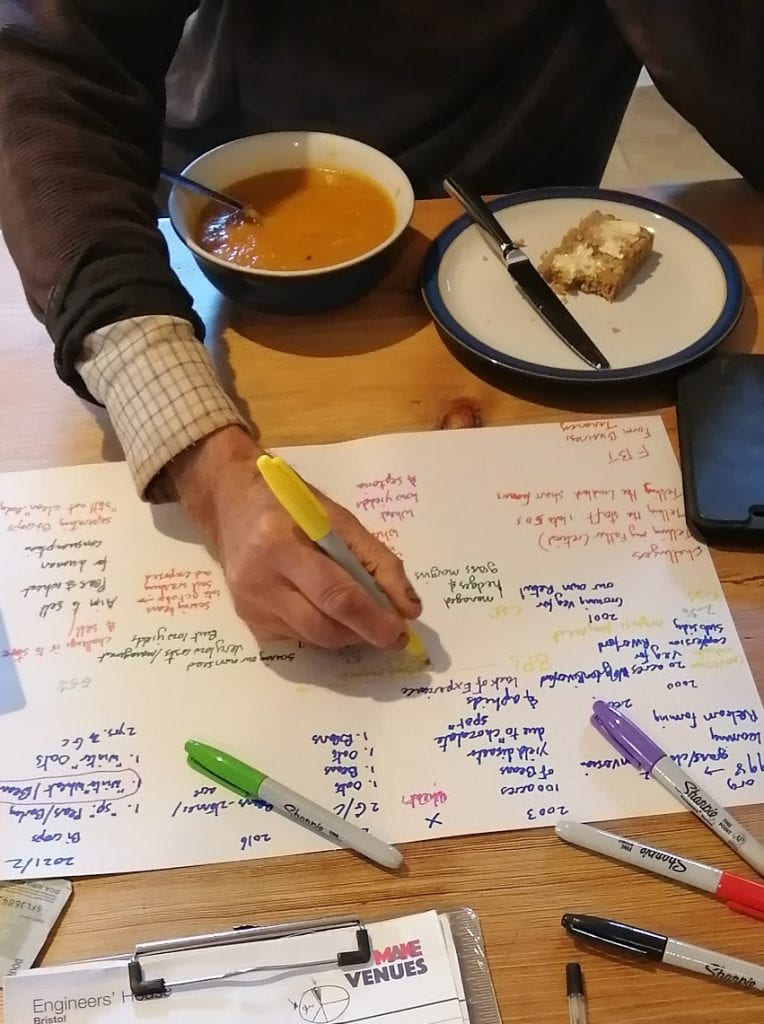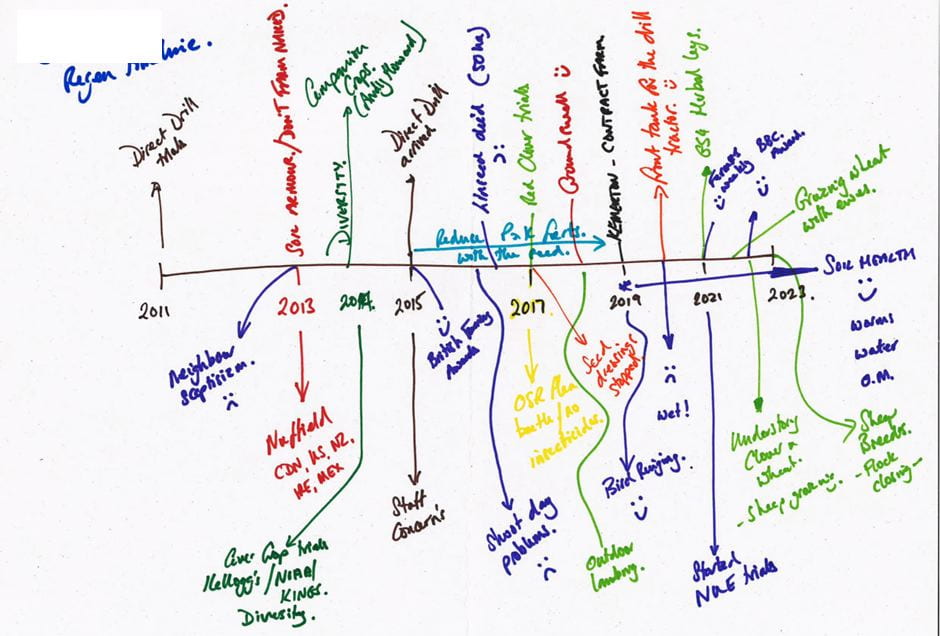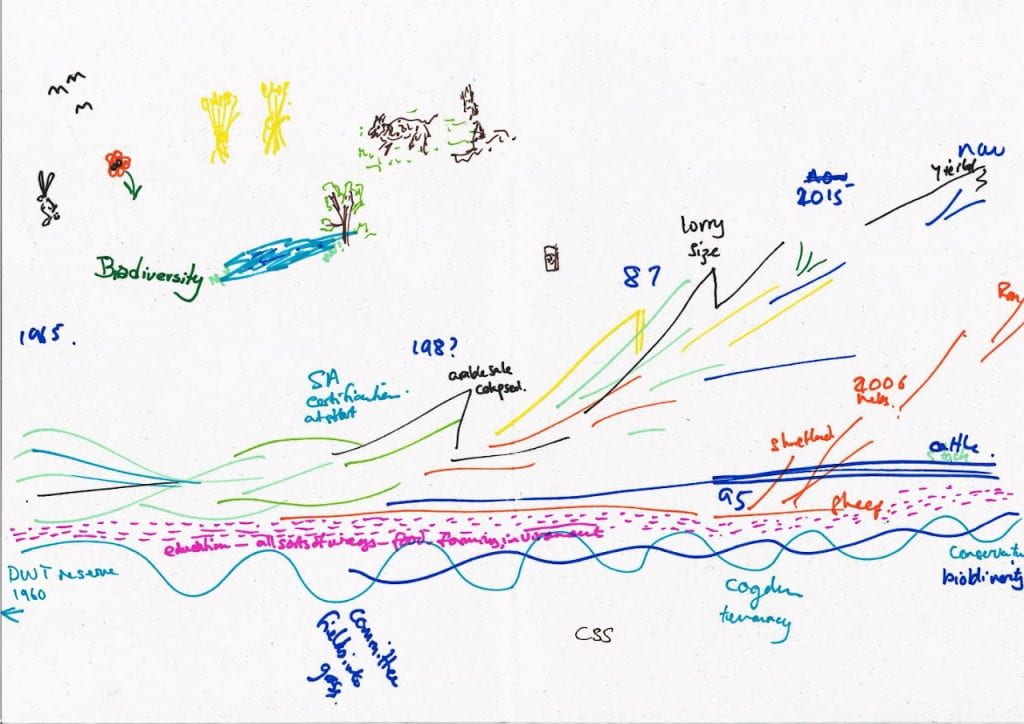By Arleen Lezcano, South West Agroecology Network.
When I set the objective of understanding farmer’s practices in the context of agricultural transition and behaviour change, I don’t think I was very aware of the challenge, especially because these types of studies require the analysis of human experiences. So how could I achieve it? I understood that human experiences are multi-modal: visual, spatial, temporal and involve physical objects (Braun, V., Clarke, V., & Gray, D. (2017). As a result a simple sit-down one-hour interview in a room wasn’t going to be the best method for this research. Here is where innovative research methods play their role. These methods also opened a range of more dynamic ways of doing qualitative research with farmers. It was a risk to put in place innovative methods in the agricultural sector which remains slightly traditional, but I had previous experience, and both the participants and I enjoyed it, so I decided to give it a chance!
Working on my current research has been exciting as it relates to my interests. It is part of the wider fungicide farming southwest project*, which studies the ecotoxicological threats of certain fungicides to drinking water, food security, aquatic life, and human health. The central objective of my research is to analyse how alternative agriculture can help to reduce the use of fungicides. I will try to answer this by identifying alternative techniques that can be used to deal with fungal diseases. The other planned action is to explore in depth the views of farmers that haven’t shifted to alternative agriculture and compare them with the challenges and solutions that alternative farmers experienced in their transition. By having a clearer picture of what the transition to alternative agriculture looks like I hope to help the farming community to accelerate the transition from farmer’s empirical knowledge and answer if alternative agriculture can help to reduce the use of fungicides.
II. Selection of method
I followed an ethnographic approach combined with innovative qualitative methods such as: walking in-depth interviews and visual methods such as graphic elicitation and timeline mapping. The ethnographic approach in the first place aimed to propitiate a safe and comfortable environment to discuss topics that could evoke distressful or sensitive memories. By following an ethnographic approach to conduct walking in-depth interviews I was able to “learn more about members of a community from the members themselves, in their own words and a natural setting” (Munz, 2017). In practical terms, I conducted in-depth interviews at the farms, walking the crops in the rain, sat on a sprayer machine, in their offices, and even in their kitchens.
The second part of the interview consisted of using timeline mapping or graphic elicitation. A timeline is a graphic representation, commonly represented using a horizontal or vertical line, where participants highlight events that happened during a certain period, in chronological order or not. Some of the benefits of using a timeline are: (1) to analyse better thought processes and behaviour change over time (Chen, 2018); and (2) to explore resilience which is one of the attributes that alternative agriculture promises and one of the current challenges of conventional agricultural systems.

III. Initial thoughts on the preliminary results
The timelines that respond better or in more detail to the transition from a synthetic chemical–based agricultural system (commonly called conventional agriculture) to an alternative were the ones drawn by participants No.1 (organic farmer) and No.9 (Regenerative farmer). These two participants transitioned from synthetic chemical–based agricultural systems, No.1 20 years ago and No.9 around 10 years ago.

By contrast, the timeline or graphic representation of participant no.6 (a couple) looks significantly different from the rest of the timelines. This timeline seems more multidimensional, with more textures, and symbols – superficially speaking, more “messy”. The participants drew ascending and descending lines that represented positive or negative experiences. They also used peak or dip points to represent successes or failures. They also used different symbols to represent their life – dashed lines, straight lines, or wavy lines. Does this differences come from the way they see their experience as long-terms organic farmers without any transition from chemical systems? Or does this just represent a different personal-individual mindset? There are loads of interesting details to explore, but I am in the analysis phase at the moment whilst writing this blog…

IV. How was the experience?
Overall, all the participants accepted to work on the timeline, and at least half of them expressed to have enjoyed doing the exercise. They mentioned that the timeline made them reflect on specific events that otherwise they just tend to forget and keep working. They also mentioned that the timeline improves or helps them to better analyse and visualize their transition journey. However, two participants didn’t produce a detailed timeline: Participant No.7 had already elaborated a timeline of his transition and also mentioned that giving details of it could take him several days. I presume that participant No.7 thinks in this way because of his academic background (Holds a PhD.). Participant No.8 didn’t finish the timeline, presumably because I conducted the interview online and he was in his car. Despite not finishing, by following the timeline structure verbally, I would say I obtained the same quality and depth of information that I got from those timelines conducted in-person.
Using graphic elicitation didn’t quite work for the objectives of this research. With the first participants we used graphic elicitation, with the hope that, by giving the freedom to represent graphically their transition or journey, challenges, topics, and ideas that we weren’t considering or that haven’t been reported would emerge, but this wasn’t the case. I suspect that the two main reasons why it didn’t work are: (1) Misunderstanding of the instructions given and (2) a lack of detail about what we were aiming for. For example, Participant No.6 mentioned it was difficult at the beginning to come out with an idea for a graphic representation – they kind of started creating drawings without time information or details, the same as Participant No.5.
V. Final reflections:
By putting together the use of innovative methods I facilitated participant’s openness and collected a great amount of in-depth data and vastly descriptive answers (I could even write a book). Farmers seemed to have enjoyed the interview and even some invited me to visit them again at their farms. A professional learning I can take from the research is to be adaptable to the current moment or circumstances – for example, when we started the interview with participant No.5, it was heavily raining so I shifted the first section to doing it indoors. However, I felt that when we were indoors his answers were short, so once the rain stopped, I asked him to go outside. After being outside he gave much more detailed answers.
Traveling around the Southwest of England and talking to conventional and alternative farmers has not just been a professional but also a personal eye-opener and enriching experience. I feel this experience provided me with a more balanced way of seeing the pressures and challenges that farmers face, how much they care about their occupation, and also their land, workers, and the food they produce independently of their farming approach; and perhaps most admirably of all, the generosity of sharing their time and knowledge for the benefit of all of us.
*Website project: fungicidefarmingsouthwest (wordpress.com)
VI. References:
-
Braun, V., Clarke, V., & Gray, D. (2017). Innovations in qualitative methods. In B. Gough (Ed.), The Palgrave handbook of critical social psychology (pp. 243–266). Palgrave Macmillan/Springer Nature. https://doi.org/10.1057/978-1-137-51018-1_13
-
Munz, E. ed., (2017). Ethnographic Interview. The SAGE Encyclopedia of Communication Research Methods. Vol. 4. Thousand Oaks, CA: SAGE Publications, Inc. https://doi.org/10.4135/9781483381411
-
Chen, A. T. (2018). Timeline drawing and the online scrapbook: Two visual elicitation techniques for a richer exploration of Illness Journeys. International Journal of Qualitative Methods, 17(1). https://doi.org/10.1177/1609406917753207/FORMAT/EPUB
About the author
My name is Arleen Lezcano, I am a Master by research student from The Cabot Institute for the environment of the University of Bristol. My study is qualitative research following an ethnographic approach combined with participant observation, walking interviews and visual methods such as graphic elicitation and timeline mapping. The central objective of my research is to analyse how alternative agriculture (organic, regenerative) can help to avoid or reduce the use of fungicides in the context of antifungal resistance. To answer this, I am identifying current barriers to transition to alternative agriculture and fungicide resistance awareness. Then, I aim to compare these barriers with the challenges that alternative farmers faced when they transitioned. Secondly, I am identifying and describing the practices that conventional and alternative farmers are currently using to deal with fungal diseases.
I have a BSc. in Environmental and Development engineering from Zamorano Agricultural University in Honduras with a diploma in adaptation to climate change. My previous research experience includes studies of water quality in Panama, vulnerability analysis of agricultural systems to climate variability in Honduras (Análisis de vulnerabilidad de sistemas agrícolas ante variabilidad climática en San Antonio de Oriente, F.M., Honduras (zamorano.edu), women’s involvement in the climate Change National Communications (TNC) on Climate Change of Panama for the UNFCC.

